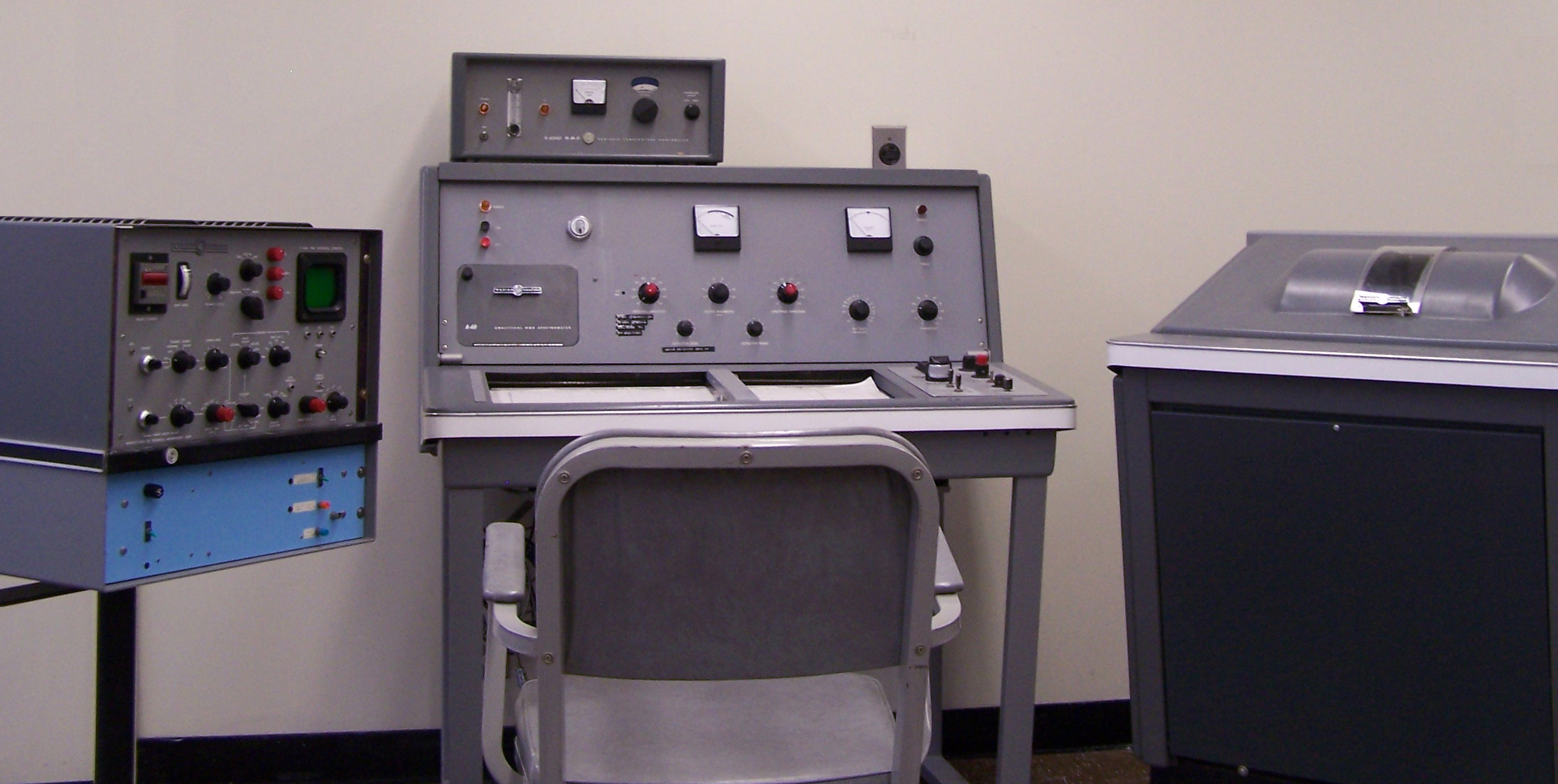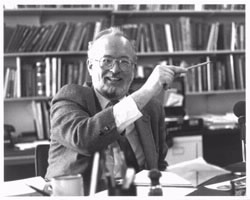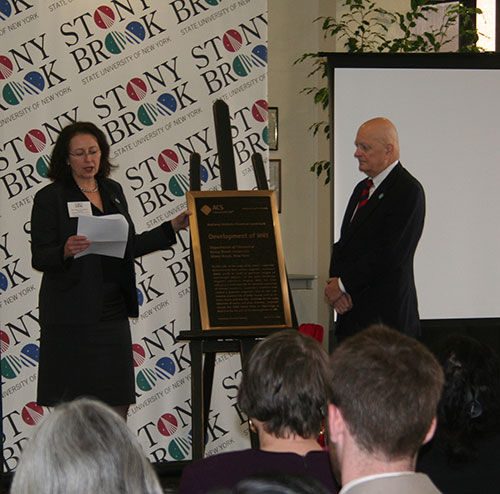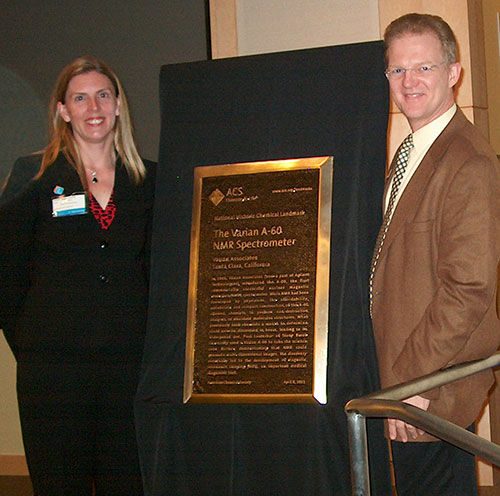NMR and MRI: Applications in Chemistry and Medicine
Designated April 26, 2011, at Stony Brook University in Stony Brook, New York, and April 8, 2011, at Agilent Technologies in Santa Clara, California.
MRI (magnetic resonance imaging) has become a staple of medical diagnostics. Millions of Americans have had an MRI; it is a useful non-invasive and non-destructive diagnostic tool for imaging soft tissues such as the brain, heart and muscles, and for discovering tumors in many organs. MRI is an application of NMR (nuclear magnetic resonance), an analytical tool of chemists found in laboratories worldwide.
Together, NMR and MRI revolutionized the practice of chemistry and medicine by providing fast, non-destructive, and non-invasive means for the observation of matter from the atomic to the macroscopic scale.
Contents
Development of Nuclear Magnetic Resonance (NMR)
Hardly a chemistry laboratory is without one. A nuclear magnetic resonance (NMR) spectrometer is the tool of choice for researchers probing chemical structures.
NMR is a phenomenon that occurs when the nuclei of some, but not all, atoms in a static magnetic field and are subjected to a second oscillating electromagnetic field in the form of radio frequency radiation, which causes the nucleus to resonate. NMR spectroscopy is the use of NMR phenomena to study the physical, chemical, and biological properties of matter. Chemists use it to determine molecular identity and structure. Medical practitioners employ magnetic resonance imaging (MRI), a multidimensional NMR imaging technique, for diagnostic purposes.
In 1945 two groups of physicists, one at Stanford, the other at Harvard, first reported the detection of NMR signals in condensed matter. The Harvard group led by Edward Purcell discovered the phenomenon in solid paraffin; the Stanford group, under the wing of Felix Bloch, found it in liquid water. Purcell and Bloch shared the 1952 Nobel Prize in Physics.
Other researchers soon discovered the chemical shift, a small variation in NMR frequency as a result of a variation in molecular electron distribution. The ability to measure the chemical shift was a boon to chemists; it meant they could perform non-destructive chemical analyses of samples to determine molecular identity and structure much faster and more simply than before.
Other advances in analyzing structure came with the discovery by Herbert Gutowsky, David McCall, and Charles Slichter at the University of Illinois of spin-spin coupling, a measure of atomic interactions within a molecule. In 1955 William Dauben at the University of California at Berkeley and Elias Corey at Illinois were the first chemists to use NMR to assign previously unknown molecular structures.
Chemists quickly realized that NMR had great utility; it allowed them to recognize the detailed structure of a molecule as they synthesized it. What had started out as a tool for physicists quickly moved into the chemical laboratory.
What is NMR?
NMR spectroscopy is the use of NMR phenomena to study the physical, chemical, and biological properties of matter. Chemists use it to determine molecular identity and structure.
The Varian A-60
In 1948 two brothers, Russell and Sigurd Varian, armed with $22,000, founded Varian Associates to manufacture scientific instruments. According to a company history, the Varian brothers “intentionally settled near Stanford in order to enjoy the benefits of interchange with the various scientific programs in progress at the University.”
Russell Varian in particular had a long association with Stanford; he had done his undergraduate and graduate work at the Palo Alto institution. In the late 1930s the brothers struck a deal with Stanford allowing access to a university laboratory to develop the klystron tube, an “electron tube” that produces microwaves. The British quickly adapted klystron tubes to radar to help stave off the Luftwaffe during the Battle of Britain.
Shortly after opening its doors, Varian Associates received a contract to develop the R-1 klystron for use in guided missiles. The R-1 contract enabled Varian to increase its workforce from a handful of employees to 30 fulltime workers. It also meant that Varian became the world leader in the production of microwave tubes.
Not wanting to remain a one-product company, Varian used its Stanford connection to develop NMR instruments, which at their most elemental consist of a magnet, a radio frequency transmitter, and a receiver. Although the first applications of NMR spectroscopy were done with hand-built instruments, Russell Varian anticipated many uses for NMR instruments. Accordingly he reached an agreement with Bloch, who served as a company consultant, to acquire the patent rights to produce NMRs.
The Stanford connection tightened with the hiring in 1951 of Martin Packard, who had worked with Bloch. Packard observed: “Prior to the use of NMR… [a chemist] could spend literally months and years trying to determine the structure of a molecule. With NMR, infrared, mass spectrometry, and other such tools, the same problems can often be solved in hours.” To help convince chemists of NMR’s utility, the Varians hired James Shoolery, a physical chemist, to set up an applications laboratory. Shoolery and his colleagues taught chemists how to use NMR to determine molecular structure.
Varian Associates first forays into NMR instrumentation yielded mixed results. At first, the company funded development of NMR spectrometers by making its 12-inch electromagnet available commercially. The initial Varian instrument was the HR-30, which used the 12-inch electromagnet, but it was difficult to operate. Later, more advanced instruments were marketed, such as the HR-40 and the HR-60. The latter instrument could solve a larger range of problems than earlier versions, and it was a small-scale commercial success. But its mammoth size and high cost put it out of the reach of most chemists.
The HR-60’s modest success convinced the company that there was a potential market for a low-cost, proton-only NMR spectrometer. Research on such an instrument began in earnest in 1957. It was code-named “ASP:” As soon as possible. The new instrument would have a six-inch magnet, small enough so that the entire instrument would fit into two secretary-sized consoles, one for the magnet and most of the electronics, the other for the controls and the remaining electronic gear. The intent was to manufacture a machine simple enough for an organic chemist to use and cheap enough for the researcher to afford.
In 1960 Varian Associates introduced the A-60: The first commercially successful NMR spectrometer. The A-60, which plotted the results, spectra, on calibrated chart paper, quickly became popular among chemists because of its affordability, reliability, stability, compact construction, and ease of operation.
The A-60 was the workhorse NMR instrument for decades as it allowed chemists to determine molecular structures easily and quickly and to follow the progress of chemical reactions. Researchers employed the A-60 in applications of special interest to the public such as prospecting for water, oil, and minerals. But the most widely known application came in the medical field with the development of magnetic resonance imaging (MRI).

Paul Lauterbur and MRI
Paul Lauterbur, who shared the Nobel Prize in Physiology or Medicine in 2003 with Peter Mansfield for the discovery of MRI, used a Varian A-60 to show that NMR could be used to generate multi-dimensional images. Lauterbur was the first to demonstrate magnetic resonance imaging; Mansfield soon improved the resolution and speed of MRI images.
After receiving a B.S. in chemistry at Case Institute of Technology in 1951, Lauterbur went to work for Dow Corning in the company’s Mellon Institute Laboratories, where he first learned how to use NMR. At the same time he was pursuing a graduate degree at the University of Pittsburgh, but before he could complete work towards the degree and a planned study on NMR spectroscopy of silicon compounds, he was drafted into the Army.
After basic training, Lauterbur was assigned to the Army Chemical Center, where he learned the Army had purchased an NMR, which apparently no one knew how to use. Lauterbur let his superiors know, “Hey, I know all about that,” which earned him a transfer to help set up the instrument and then to continue research using it. Lauterbur published four papers based on his work on NMR in the Army.
After the Army, Lauterbur says “two options developed:” go the University of Illinois as a graduate student to study with Gutowsky or persuade Mellon to buy an NMR spectrometer. Mellon declined, but Dow Corning came through, so Lauterbur went back to the Mellon Institute where his NMR studies led to the detection of the stable carbon-13 isotopes’s magnetic resonance. This work provided the basis for his Ph.D. dissertation, which in turn led to his appointment as an Associate Professor of Chemistry at the State University of New York at Stony Brook in 1969, where Lauterbur pursued two areas of research, both of which led to NMR imaging. One of those areas was the use of computers to acquire and process NMR information, and the other was the application of NMR information to biological studies.
In 1971 Lauterbur assumed temporary control of a financially troubled company near Pittsburgh that made specialized NMR equipment – NMR magnets and pulse RF NMR systems. While there, Raymond Damadian, who had been using NMR to study biological samples, visited to use some of the company’s equipment. Damadian’s studies showed that the water proton T1 NMR relaxation time constants in healthy and tumor tissues in rats differed, and he wrote a paper suggesting this might be a way of diagnosing tumors. As Lauterbur later wrote, “the attention of the medical community was first attracted by the report of Damadian that some animal tumors have remarkably long water proton NMR relaxation times.”
Lauterbur observed Damadian’s experiments and was impressed with the results, which promised to give pathologists a new tool in studying diseased tissues. But he concluded that “the invasive nature” of removing tissue to study it ex vivo with NMR measurements undermined NMR’s potential as a diagnostic technique. “I knew,” Lauterbur later said, “that biopsies were commonly done and examined by histologists, and I believed that NMR relaxation time measurements on tissue specimens were unlikely to contribute much to the rich variety of information available from optical microscopy.”
Instead, Lauterbur wondered: Might there be a way to know the water proton NMR relaxation time constants of tissues without having to take them out of the body, to determine exactly where an NMR signal originates in a complex object such as a living organism? In other words, was there a way to get spatial information out of NMR signals in vivo?
Back at Stony Brook, Lauterbur found an elegant solution to the problem that involved, in effect, turning NMR inside out. He used magnetic field gradients to encode spatial information into the NMR signals. A gradient is the variation of magnetic field strength with position. Since the frequency of an NMR signal is directly proportional to the magnetic field strength, if the field varies in position then the resonance frequency also will vary. For thirty years, NMR researchers had passed electric currents, called shim currents, through shim coils of wire to manipulate gradients. The idea was to eliminate field gradients, the spatial variations, because they prevented sharp NMR signals.
By “shimming the magnet” researchers obtained unique chemical information but lost all spatial information. Lauterbur decided that instead of eliminating the gradients he would use “sets of linear gradients oriented in different directions” to give a multidimensional image of the NMR signal, which would in turn allow an investigator to make a three-dimensional picture. Not long afterward, Lauterbur demonstrated how to obtain chemical and spatial information simultaneously – magnetic resonance spectroscopic imaging.
Lauterbur’s initial experiments using the A-60 were performed on glass capillaries of water. But in the 1973 Nature paper announcing his results, Lauterbur mused that “a possible application of considerable interest… would be to the in vivo study of malignant tumors” whose proton NMR signals had much longer relaxation time constants than healthy tissues.
Peter Mansfield, a British physicist, showed how MRI’s radio signals could be analyzed mathematically, making it possible to develop a useful image of those signals. Mansfield also developed an MRI protocol known as echo-planar imaging, which makes it possible to develop MRI images much faster than previously possible. This in turn led to the introduction of functional magnetic resonance imaging (fMRI), a specialized MRI scan useful in neural imaging.
MRI, a procedure first developed in the 1970s, has become a staple of medical diagnostics. Millions of Americans have had an MRI; it is a useful non-invasive and non-destructive diagnostic tool for imaging soft tissues such as the brain, heart, and muscles, and for discovering tumors in many organs.
Further Reading
- Celebrating the Birth of MRI (Stony Brook University, Department of Chemistry)
- Company History (Agilent Technologies)

Landmark Designation and Acknowledgments
Landmark Designation
The American Chemical Society designated the development of MRI by Paul Lauterbur as a National Historic Chemical Landmark at Stony Brook University in Stony Brook, New York, on March 8, 2011. The text of the plaque commemorating the development reads:
On this site, in the early 1970s, Paul C. Lauterbur demonstrated that nuclear magnetic resonance (NMR) could be used to generate images of macroscopic objects. In the years following, magnetic resonance imaging (MRI) has been refined as a technique for the detailed resolution of internal structures. Lauterbur’s invention thus created a powerful diagnostic tool for the non-invasive examination of body tissues such as the brain, heart, and muscles. It allows for the early detection of cancer and other diseases. Lauterbur shared the 2003 Nobel Prize in Physiology or Medicine for his role in the development of MRI.
The development of the Varian A-60, the first commercially successful NMR instrument, was designated a National Historic Chemical Landmark on April 8, 2011, at Agilent Technologies in Santa Clara, California.
In 1960, Varian Associates (now a part of Agilent Technologies) introduced the A-60, the first commercially successful nuclear magnetic resonance (NMR) spectrometer. While NMR had been developed by physicists, the affordability, reliability, and compact construction of the A-60 allowed chemists to perform non-destructive analyses to elucidate molecular structures. What previously took chemists a month to determine could now be discovered in hours, leading to its widespread use. Paul Lauterbur of Stony Brook University used a Varian A-60 to take the science even further, demonstrating that NMR could generate multi-dimensional images. The discovery eventually led to the development of magnetic resonance imaging (MRI), an important medical diagnostic tool.
Acknowledgments
Adapted for the internet from “NMR and MRI: Applications in Chemistry and Medicine,” produced by the National Historic Chemical Landmarks program of the American Chemical Society in 2011.
Learn more: About the Landmarks Program
Take action: Nominate a Landmark and Contact the NHCL Coordinator




